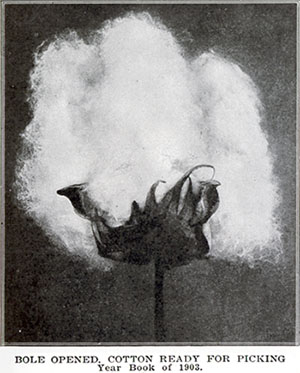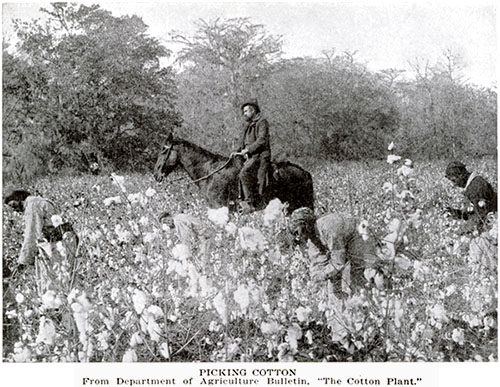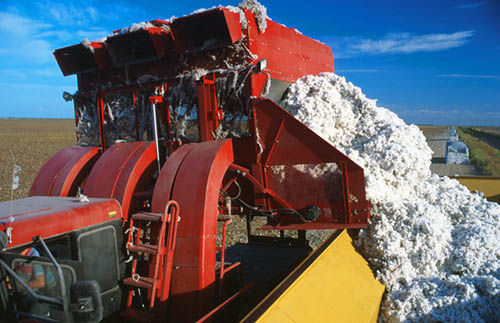Cotton
Today, think about cotton. The University of Houston's College of Engineering presents this series about the machines that make our civilization run, and the people whose ingenuity created them.
A friend commented the other day that cotton once dominated Texas' economy. That's easy to forget in this land of petrochemical plants and high tech industry. Yet Texas once produced a quarter of the world's cotton. Now the total US cotton production is less than a quarter of the world's supply. China, India and Pakistan produce about half of it.
But, two centuries ago, the invention of the cotton gin drove America cotton production relentlessly. Cotton fueled the institution of slavery. And yet, America's real cotton heyday would come after the Civil War. American cotton production was less than five million bales a year on the eve of War. Here on the western frontier, cotton growing was still in its infancy. Texas grew only ten percent of the national total in 1860.
After the War, plantation owners, now served by new rail systems, moved west. The bitterly hard task of harvesting cotton now fell, not to slaves, but to sharecroppers -- both black and white.
Europe was hungry for our cotton, and American production soon tripled. It reached eighteen million bales by 1937 -- over five million of which were grown in Texas. How much cotton is that? Well, Texas alone could've filled a cube the height of the Washington Monument. That is a lot of cotton.
 To catch a glimpse of the importance of cotton a century ago, just open the 1911 Encyclopaedia Britannica. Fifty-one pages, two-columns, small print -- enough to fill a small book. (Of course, this British source focused on cotton as an import commodity, while we saw it as an export.) The highest grade was sea island cotton with its luxurious two-inch fibers. It claimed three times the price of Texas cotton with its one-inch fibers. But there was little sea island cotton to be had; it was a small part of the picture. Texas cotton was almost as good as Egyptian cotton and somewhat better than Indian cotton.
To catch a glimpse of the importance of cotton a century ago, just open the 1911 Encyclopaedia Britannica. Fifty-one pages, two-columns, small print -- enough to fill a small book. (Of course, this British source focused on cotton as an import commodity, while we saw it as an export.) The highest grade was sea island cotton with its luxurious two-inch fibers. It claimed three times the price of Texas cotton with its one-inch fibers. But there was little sea island cotton to be had; it was a small part of the picture. Texas cotton was almost as good as Egyptian cotton and somewhat better than Indian cotton.
As we trace old production records, the tracks of the dreaded boll weevil loom large. It entered Texas from Mexico in 1892 and, within 30 years, had blighted American cotton everywhere. Weevils have wrought havoc ever since. They still cost America around a third of a billion dollars a year. The good news is: a second invader from the south, the fire ant, is now savaging the weevil population.
So much has changed today. Genetically modified cotton allows us to reduce the pesticides needed to protect it. Mechanical cotton harvesting machines appeared in the 1920s, and became fully effective after the '50s. Those machines also strip out cotton seeds and package them into ten-ton "bricks."
So I stand by a country road in my crisp cotton shirt, scanning the vast south Texas horizon. My shirt will soon enough wilt under the heat and humidity. Missing from the scene are the bent backs of sharecroppers -- their toil now borne by machines. And my cool shirt? Well, it's most likely now made of Chinese cotton.
I'm John Lienhard at the University of Houston, where we're interested in the way inventive minds work.
K. H. Watson. Textiles and Clothing; Vol. X, The Library of Home Economics. (Chicago: American School of Home Economics, 1907): pg. 28-35. Both black-and-white photos are from this source. The color photo below is courtesy of Wikipedia.
See entries in the Texas Almanac for years from 1860 through 1939-40. My thanks to Bobby Marlin, Special Collections, UH Library, for locating valuable information on cotton from these sources. Thanks also Margaret Culbertson for her insights into the cotton industry in the Waxahachie region, and to Lewis Wheeler for suggesting the topic.
See also the Wikipedia entries on cotton, and on the boll weevil.

Cotton picking as represented, without comment, in a 1907 textiles textbook.

A large cotton harvesting machine in Texas. It is offloading the picked cotton into a second machine that forms it, not into bales, but into much larger modules for shipping. These modules can be seen on the ground in the middle right.